| dc.description.abstract | This thesis consists of three essays on commodity-linked investment decisions under uncertainty. Specifically, the first essay investigates whether a regime switching model of stochastic lumber prices is a better model for the analysis of optimal harvesting problems in forestry than a more traditional single regime model. Prices of lumber derivatives are used to calibrate a regime switching model, with each of two regimes characterized by a different mean reverting process. A single regime, mean reverting process is also calibrated. The value of a representative stand of trees and optimal harvesting prices are determined by specifying a Hamilton-Jacobi-Bellman Variational Inequality, which is solved for both pricing models using a fully implicit finite difference approach. The regime switching model is found to more closely match the behavior of futures prices than the single regime model. In addition, the optimal harvesting model indicates significant differences in terms of land value and optimal harvest thresholds between the regime switching and single regime models.
The second essay investigates whether convenience yield is an important factor in determining optimal decisions for a forestry investment. The Kalman filter method is used to estimate three different models of lumber prices: a mean reverting model, a simple geometric Brownian motion and the two-factor price model due to Schwartz (1997). In the latter model there are two correlated stochastic factors: spot price and convenience yield. The two-factor model is shown to provide a reasonable fit of the term structure of lumber futures prices. The impact of convenience yield on a forestry investment decision is examined using the Schwartz (1997) long-term model which transforms the two-factor price model into a single factor model with a composite price. Using the long-term model an optimal harvesting problem is analyzed, which requires the numerical solution of a Hamilton-Jacobi-Bellman equation. I compare the results for the long-term model to those from single-factor mean reverting and geometric Brownian motion models. The inclusion of convenience yield through the long-term model is found to have a significant impact on land value and optimal harvesting decisions.
The third essay investigates the dynamics of recent crude oil prices by comparing and contrasting three different stochastic price models, which are a two-state regime switching model, a two-factor model analyzed in Schwartz (1997) and a two-factor model examined in Schwartz and Smith (2000). Prices of long-term crude oil futures contracts are used to calibrate and estimate the model parameters. The performances of the two-factor models are comparable in terms of fitting the market prices of the long-term oil futures contracts and more closely match the behavior of oil futures prices than the regime switching model. | en |

